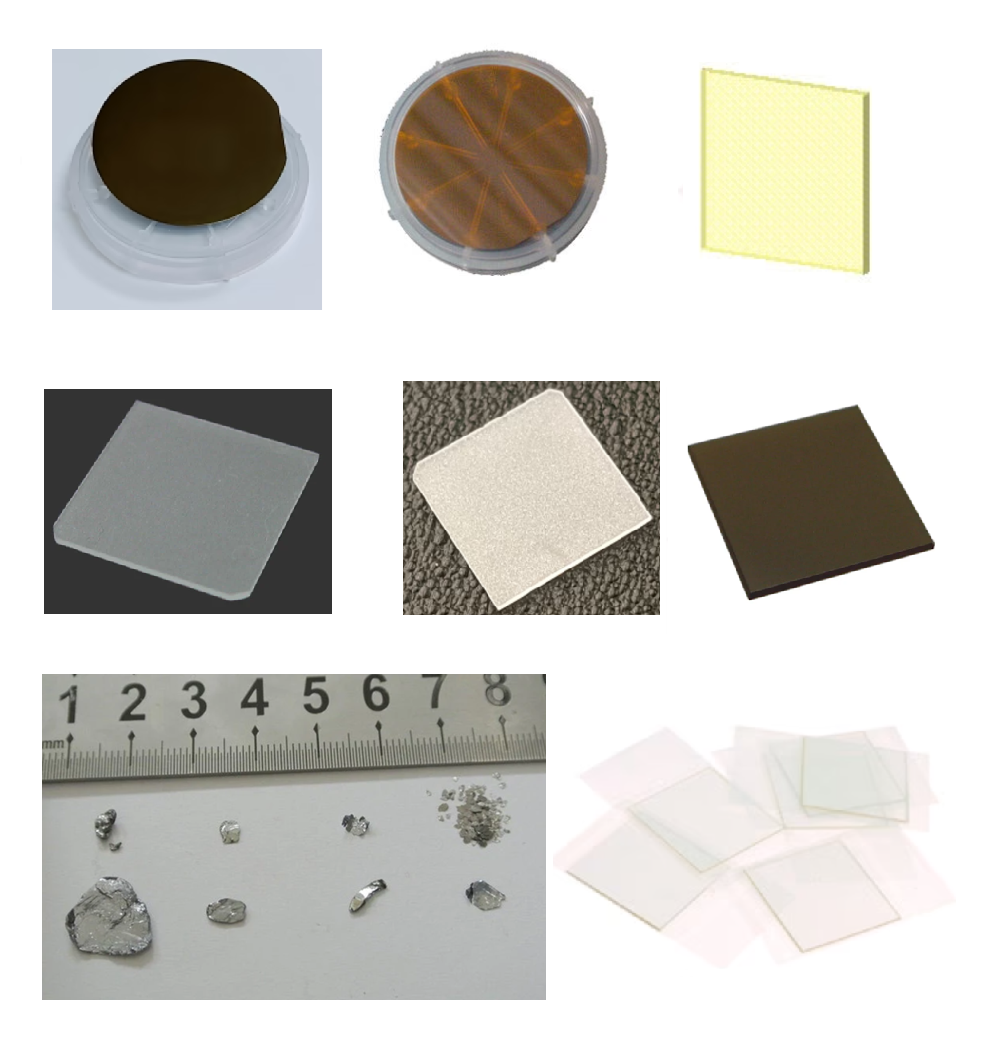MTI Corporation offers a wide selection of high-quality crystalline materials, supporting research in microelectronics, photonics, quantum technology, and energy systems. Their crystal portfolio includes semiconductors, insulators, metals, optical and many other materials, each selected for its structural integrity, purity, and consistency. This variety reflects the range of physical properties—electrical, optical, thermal, and mechanical—needed in scientific experiments and device development. MTI has multiple types of crystal materials, such as semiconductors, conductors, insulating materials, optical etc.

Semiconductor crystals
Semiconductor crystals in MTI’s catalog range from materials such as germanium to compounds like gallium nitride and cadmium telluride. These materials have electrical conductivities between those of metals and insulators, and their properties can be tuned through doping, strain, structural engineering etc. They are used in transistors, LEDs, laser diodes, infrared sensors, solar cells, and thermoelectric generators, where their crystal quality and band structure directly influence device efficiency. An example of a promising semiconductor material from MTI’s list is black phosphorus. It is a layered semiconductor whose band gap varies from about 0.3 eV in bulk form to around 2 eV in a single layer, making it highly tunable for electronics and optoelectronics. It exhibits high carrier mobility and pronounced in-plane anisotropy, enabling devices with directional electrical and optical responses.
Insulating crystals
Insulating crystals feature wide band gaps that suppress electrical conduction under normal conditions. They are often used as substrates for semiconductor epitaxy, optical components, and dielectric layers. Key parameters such as lattice match, optical transparency, and thermal expansion determine their suitability for specific applications.
Conductors
Conductors include both metallic and nonmetallic materials with high free-electron density or delocalized bonding networks that enable efficient electrical and thermal conductivity. Metals such as silver, copper, gold, and aluminum are used extensively for electrical interconnects, electrodes, and thermal management components. In crystal research, metallic substrates and thin films can serve as seed layers, reflective coatings, or contact materials for semiconductor and optical devices. Some conductive materials in crystalline or polycrystalline form (e.g., Mo, W, Ni) are also used in high-temperature environments, thin-film growth, and as diffusion barriers in microelectronics. Their properties are defined by low resistivity, ductility, and strong interaction with electromagnetic fields.
Magnetic materials
Magnetic materials possess ordered magnetic moments that make them valuable for applications in spintronics, magnetic sensing, and electromagnetic shielding. Some are electrically insulating, while others combine magnetic ordering with electrical conductivity.
Optical, laser and scintillator crystals
This category includes materials that interact strongly with light through transmission, reflection, refraction, or luminescence. Optical crystals are used for lenses, windows, and nonlinear frequency conversion. The scintillator crystals emit photons when struck by ionizing radiation, enabling radiation detection and imaging. Laser crystals contain active ions that amplify light when optically or electrically pumped. These materials are characterized by high optical transparency in specific wavelength ranges, well-defined refractive indices, and in some cases, precise dopant incorporation for tailoring emission spectra. Their performance depends heavily on crystal purity, defect density, and control of optical anisotropy. MTI provides such interesting materials as single crystal yttrium aluminum garnet (YAG, Y3Al5O12). It is one of the most widely used laser materials nowadays. Optically transparent single crystal YAG is used as optical host materials in various solid-state lasers for its outstanding optical properties when doped.
MTI’s crystals list :
Semiconductors |
Insulators |
Conductors |
Optical |
Magnetic |
Other |
| AlN (Aluminum Nitride) | Al₂O₃ (Sapphire) | Ag / Silver | BaF₂ | Fe₃O₄ | PET Film |
| Bi₂Te₃ | BaTiO₃ | Aluminum | Bi₄Ge₃O₁₂ (BGO12) | GGG & SGGG (magnetic garnet) | 2D Crystal |
| Black Phosphorus | CaCO₃ (Calcite) | Au / Gold | Bi₁₂GeO₂₀ (BGO20) | YIG | Zero Diffraction Plates for RXD |
| CdS | CaF₂ | Au/Cr coated SiO₂/Si | CeO₂ (Epi-film) | ||
| CdSe | KH₂PO₄ | Co | CsI(Tl) | ||
| CdTe & CdZnTe/CZT | KTaO₃ | Cu | CsPbBr₃ | ||
| Ga₂O₃-β | KTN | Fe (SS-Poly) | Diamond | ||
| GaAs | LaAlO₃ | Mg | GSGG & GYSGG | ||
| GaN | LaF₃ | Mo (Polycrystal) | InP (also optoelectronic) | ||
| GaP | LiAlO₂ | Nickel | La₃Ga₅SiO₁₄ | ||
| GaSb | LiF | Ti (Polycrystal) | LiNbO₃ | ||
| Ge | LiGaO₂ | W (Polycrystal) | LiTaO₃ | ||
| InAs | LSGM | Zn | Lu₂SiO₅:Ce | ||
| InP | LSAT | MgAl₂O₄ (Spinel) | |||
| InSb | MgF₂ | MoS₂ | |||
| PbS | MgO | MoSe₂ | |||
| PbSe | Mica | MoTe₂ | |||
| PbTe | NaCl | NdAlO₃ | |||
| Si | Nb:TiO₂ | NdCaAlO₄ | |||
| SiC (4H, 6H, 3C) | NdGaO₃ | NGG (Nd₃Ga₅O₁₂) | |||
| SmScO₃ | SBN | PbWO₄ | |||
| SOI | ScMgAlO₄ (SAM) | PMN-PT | |||
| SOS (Silicon on Sapphire) | SiO₂ (Quartz) | SrLaAlO₄ | |||
| WS₂ | SrLaGaO₄ | SrTiO₃ | |||
| WSe₂ | TbScO₃ | TeO₂ | |||
| WTe₂ | TiO₂ (Anatase) | TGG | |||
| ZnO | TiO₂ (Rutile) | YAG | |||
| ZnS | YAlO₃ (YAP) | YSGG (Y₃Sc₂Ga₃O₁₂) | |||
| ZnSe | YSZ | YVO₄ | |||
| ZnTe |
For more information, please visit : https://mtixtl.com/en-euea/collections/crystals
contact us at contact@accessr-energy.eu


